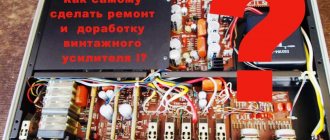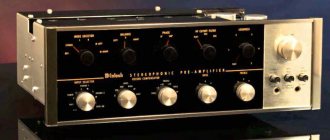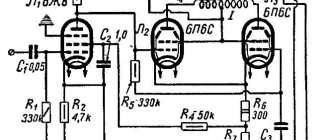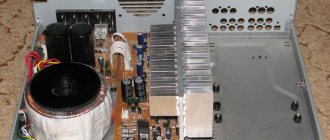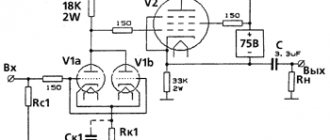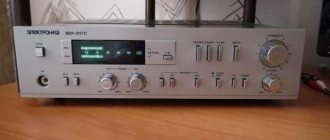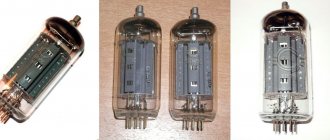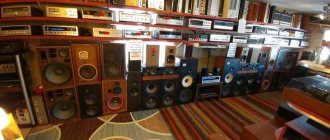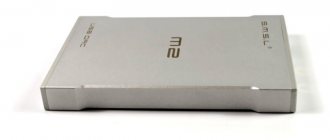Domestic tube amplifiers - a worthy alternative to brands or a sad compromise?
I’m reading about mental anguish and doubts, and I don’t understand what is missing or cannot be missing in principle in a well-functioning amplifier from domestic “homemade” ones or a domestic brand? A lamp power of 10-25W per channel is enough for any room... if the speakers have a sensitivity of 92-97dB. )) My acoustics on 4a32V heads ask me to take them out into the open field already at half the volume! (and in the room 2-5W is enough for the eyes!) This is our domestic Soviet “consumer consumer goods” that was found in the majority of variety equipment and in cinema halls. He needs space... or a box of at least 200 liters! What do we even want to hear?!))) How will a cool tube foreign speaker with cool bookshelf speakers (I mean cool prices) radically change the original sound of Marshall and Fender heads and cabinets in rock recordings? Well, I’ll understand if we compare studio recordings of live music and vocals, winds, strings, etc. (symphonies, opera, jazz...). Everyone has their own musical inclinations, their own unique ear (or lack thereof). Maybe some foreign copies are universal for all styles. (Fairy tale!)
Here, apparently, you need to think in terms of “like”/“dislike.”
Even with the most sophisticated ear for music, you may not be able to see the difference between a foreign device and our domestic one (with a 10-fold difference in price!) when listening blindly. The same amplifier often produces a different impression, even when replacing the tubes with their complete analogues from a different batch.
The output transformer can be ordered overseas, if ours is not trusted, and everything else for it will be calculated and manufactured in the best possible way (including the power supply - the second important component for any wuxia). Amplifier circuits have hardly changed in 50 years! ))) Just start as expected, with acoustics (including the listening room).)) There is no one “pill” on this topic. One needs sound, the other needs graphics from a spectrum analyzer. One doesn't want to see, the other doesn't want to listen.)))
(Regarding the horizontal arrangement of the lamps... - if the passport says “any”, then don’t worry about the sagging of the grids. On the 5ts3s it says “vertical” working, yes.)) For the rest, the cathode is more likely to deny you proper emission, than the grid will sag.))) Even in guitar amplifiers, where the preliminary stages are overloaded and sometimes fry at anode voltages higher than the rated ones, I have not noticed any problems from sagging grids over the past 40 years. )
Music lover's magic lamp
Strictly speaking, there is probably no point in making a detailed presentation of tube amplifiers - in previous reviews all this was presented in a rather detailed form. But we note that in the current marathon, mainly push-pull models are taking part, where pentode and triode type amplification lamps are used. Such circuits provide relatively high output power in contrast to “lighter” single-ended circuits. Now there are many offers on the tube amplifier market, but the price range is very wide, from Asian “folk” models for five hundred American banknotes to the top of the hierarchical ladder, called High End, with price tags of half a million rubles or more. Our task is to identify the golden mean, those devices that would be affordable, but do not suffer from significant compromises. The design of almost all competitors is basically the same. This is a massive and heavy flat chassis, three transformers in cubic-shaped casings, and in front of them, like chess pieces, there are lamps of different sizes and purposes, the number of which can also vary, depending on the circuit. The front panel, traditionally made of milled aluminum, contains two or three round knobs and several buttons; there is nothing new in their set: a power switch, a volume control, an input selector and sometimes a channel balancing knob. It's rare to find a headphone jack. Some models are equipped with a motorized volume control and input selector and have ascetic but heavy remote controls, while others have exclusively manual controls. The presence of a built-in phono stage is not the rule, but rather the exception. But three screw terminals for each channel for connecting speaker cables has long been the norm: acoustics of different impedance require an individual approach. The number of stereo input pairs is also not the same: some devices have only two, others have up to five, plus some also have outputs for a monitor loop or a preliminary amplification stage. Let us note that venerable lamp brands often use Russian-made lamps in their equipment, most of which are produced in Saratov, and then, through the main office in St. Petersburg, they go overseas and to Europe. And we, Russian music lovers and experts, are very pleased to pick up such a radio component, which, in addition to the Electro-Harmonix inscription (the lamps are sold under this brand in the USA), bears the “Made in Russia” mark. And what can we say, since our amateur radio craftsmen still use Kazakhstani components from the mid-60s in their creations - military production has always held its mark highly. Although, of course, lamps currently produced in the Czech Republic and China are also popular. There is one more nuance: only some of the amplifiers have powerful metal protective caps with cells. On the one hand, protection from dust is minimal, but, say, such covers will protect the lamps well during transportation or from the playful hands of small and inquisitive future music lovers. And the point is not even that the young researcher can break the lamp by pulling it towards himself, but the high probability of burns. There are also devices made in a reliable closed case. This, of course, is practical, but it adversely affects the design, because manufacturers of such equipment often try to show off the lamp equipment, and the ventilation in closed models leaves much to be desired. The audition took place in our acoustically prepared room, with each amplifier warming up for 30 minutes. The final verdict was based on points for design, functionality and build quality, but the main criterion was sound.
Test system:
RUSSIAN Hi-End
The “Russian Hi-End” exhibitions seem to be becoming regular again - after a seven-year break, this is the second in a row, and the twelfth overall. It was held, like a year ago, at the MTUSI Congress Center through the efforts of its permanent organizer Dmitry Svoboda.
Rector of MTUCI A.S. Adzhemov and Dmitry Svoboda open the exhibition. In the center is an installation of a pre-war broadcast dish and an mp3 player. It sounded really good
The permanent exhibition is located in the spacious hall on the second floor, where, thanks to the low ceiling with sound-absorbing coating, there were very good listening conditions. Throughout the day, there were sound demonstrations "in the round", where listeners and chairs moved from one system to another. In addition, on the ground floor, in the Exclusive room with improved acoustic treatment, more thoughtful auditions took place according to a schedule that was periodically displayed on a large LCD panel in the foyer.
The exhibition was covered live on the student radio station “Radio-Tochka” MTUSI - a very interesting undertaking.
The composition of the participants was updated by about a third, which significantly revived the interest of visitors. High-end, and even created by hand, sometimes by single enthusiasts, is clearly not an industry where new products appear every year. However, the luminaries of domestic audio do not stand still.
Interestingly, many people are gradually losing their passion for tubes; for the first time in the entire existence of the exhibition, there were more transistor amplifiers than tube amplifiers. The reason I see is that transistor ones are much simpler and cheaper to manufacture (expensive output transformers are not needed, and you can buy a ready-made case, already with heat sinks), in addition, it is easier to select acoustics for them. Accordingly, such an amplifier is more likely to be sold, because we are not talking about radio amateurs, but about companies working for profit. By the way, some of the exhibits were sold on the first day, immediately after the audition.
Another interesting point is the emergence of advanced digital technology and the use of computers as sources. For example, Indigo Audio Technologies (St. Petersburg - Moscow) has released a DAC amplifier equipped with a FIFO input buffer and supporting data formats up to 24 bit/192 kHz. Under the EcoSound brand, an audio server was shown with a great on-screen interface, a 512 GB hard drive and a built-in 100-watt power amplifier.
Of course, there were tube designs and vinyl players - how would it be in the high-end without this.
There is clear progress in the ability to present their products in public and select musical material. Speeches in which the authors outlined their concept - and with them, as a rule, auditions for "Exclusive" began - became more specific and meaningful
A live concert by the Alex Rostotsky trio was organized in the conference hall with stunning video footage, which attracted many listeners. Perhaps familiarization with live music (although in this case almost all parts, except percussion and saxophone, were synthesized) will also become a tradition over time.
What else I liked was the large number of visitors, especially on weekends. MTUSI students also showed noticeable interest, and among those who were older, there were many who were interested in constructing home audio equipment.
In describing specific exhibits, I tried to focus on new items that were not in last year’s report. By the way, it can be found at https://www.salonav.com/arch/2012/05/032.htm.
High-linearity amplifier "Sirius" from MWM. The bridge output stages use domestic field-effect transistors KP904A.
The power is low, only 50 W, but the main emphasis was placed on natural sound, as close as possible to the sound of “live” instruments
- an old-timer of the “Russian High-End”, who participated in the very first exhibitions. Specializes in tube amplifiers and omnidirectional acoustics. Currently engaged mainly in custom installations
Valery Gilev's system: Crystalvox Stalker II speaker systems, Wavac tube monoblocks and cables of our own design. Note the external crossover
The Alexa range has been expanded with the Turn 1 vinyl player, created in collaboration with the German company Block. It supplies motors, discs and tonearms, everything else is done at the factory in Shcherbinka. The main design feature is precise tracking, which allows the use of an MC cartridge with a clamping force of 0.6 g. The conductive mat conducts static charges through the spindle to ground
Previously, Anashkin Laboratory specialized in tube amplifiers, but recently released a hybrid amplifier with a power of 200 W at 4 Ohms. The output stages are built on
field-effect transistors 2SK1058/2SJ162, five pieces per arm
The new brainchild of Konstantin Musatov is the Anthracite 6C33C integrated circuit with full remote control and processor control of lamp modes. From the remote control you can switch the output stage to modes “A” or “AB”. A new transistor amplifier has also been developed, which should soon go into production
Vladimir Starodubtsev (, Taganrog) decided to make a budget amplifier that is not inferior in sound quality to older models. Only the output power has been reduced (8 W per channel), other characteristics are at the same level. At the output - double triodes 6N13S in parallel connection
Alex Rostotsky's performance with dynamic video projection is one of the most striking events of the exhibition
Previously, it produced winding products for do-it-yourselfers, and a few years ago finished designs appeared. New - push-pull amplifier on 6L6 with polished silver design
Check out the design of the VicSound hybrid amplifier: a discrete volume control, a powerful W-shaped transformer and an anti-aliasing filter made from many low-power capacitors. The company also has another model where the output transistors are powered from high-efficiency switching sources
According to the creators of Dorius acoustics, it uses a new low-frequency design principle - a multi-chamber acoustic transformer. A patent was even received for the invention. These chambers are located in the lower part of the structure, and the upper one is a spiral horn that forms a sound wave front that is as close as possible to a cylindrical one. This brand also produces acoustics of the traditional “box” type, but it uses the same principle
The 40-watt single-ended AudiostandArt on the GM-70 has a gain bandwidth at full power of 25 Hz - 60 kHz. Thanks to deep feedback, distortion is radically reduced; the spectrum contains mainly the second harmonic. The amplifier uses its own circuitry with cathode followers between all stages
They haven't even chosen a name for this device yet. It will combine a DAC, pre-amplifiers and final amplifiers, as well as a computer with a 512 GB hard drive. The main idea is to create a universal and extremely accurate system for playing digital audio, which does not require interconnect cables. Distortion of the built-in amplifier at a power of 100 W - thousandths of a percent
Helium speaker systems are built on the basis of 4-way coaxial speakers. They have three independent diffusers (the largest is 15 inches) with their own magnetic systems and a tweeter in the center. Acoustic design - “variovent”, first-order filters on film capacitors and Physics Style cable wiring. The acoustic and interconnect cables in the system are of the same brand. Sensitivity 96 dB
share
Tags: Russian Hi-EndFrom the scene
